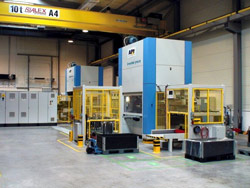2009-12-21
Reliability is important when production tempo is high,
AP&T takes total responsibility at ABB

When the ABB industry group wanted to establish a new production plant for the manufacture of industrial electric motors in Poland, they needed a production solution to manufacture motor rotors and stators out of sheet metal. With a total undertaking following the One Responsible Partner® concept, AP&T took on the challenge and thereby made its debut in Poland.
The parts are made of 0.5 mm thick sheet metal and ABB needed a high production rate – a task better suited to a mechanical press than a hydraulic press due to the material thickness and tempo requirement. It was here that AP&T's expanded One Responsible Partner® concept proved well suited.
“In addition to production solutions with AP&T hydraulic presses, our total offering now includes mechanical presses from our partner Invernizzi,” says Per-Arne Mattsson, who serves as Automation Production Manager at AP&T.
Smooth work method
ABB found the One Responsible Partner® concept quite appealing. It means that the client works with a single party that takes full responsibility for the entire production solution during the entire project phase, from the idea stage to a production process that is completely up and running.
“Naturally, it is a great advantage to have a partner that delivers a turnkey, fully functional system and takes responsibility for the entire chain instead of us having to be responsible for integrating different systems with each other,” says Hans Söderback, Plant Supervisor at ABB.
Automated without interruption
AP&T met ABB's production needs with two automated press cells with mechanical presses. In the first press cells, round parts are stamped out of a band. To maximize material exchange, the band is fed into the cell in a zigzag pattern. The stamped blank follows with the top of the tool and, with the help of AP&T's walking beam, is fed out to a stacking unit that automatically stacks the blanks on a pallet and shifts to a new pallet when that one is full – without any interruption to production. The band remains are cut into small pieces by a mechanical shears in the press for optimal packing of the scrap metal.
Part is cut
In the second press cell, the blank is divided into two parts – rotor and stator metal. The blank is cut and the inner part – the rotor metal – falls down onto a conveyor belt and is stacked. The outer part – the stator metal – is transported away and stacked for further machining.
Focus on reliability
An important challenge of the project was making the cycle time as short as possible while maintaining a large degree of reliability.
“It doesn't matter how fast the process is if you have to deal with malfunctions,” says Per-Arne Mattsson.
Reliable standard
Reliability was one of the main reasons that AP&T won the assignment over stiff competition from several other companies.
“We know that AP&T builds its production solutions from standardized and reliable modules that have proven to keep downtime to a minimum. And, if we need their help, it's never far away, says Hans Söderback.